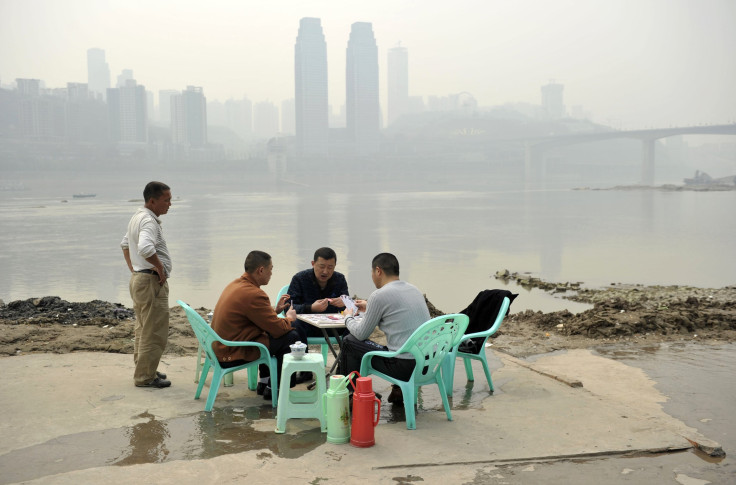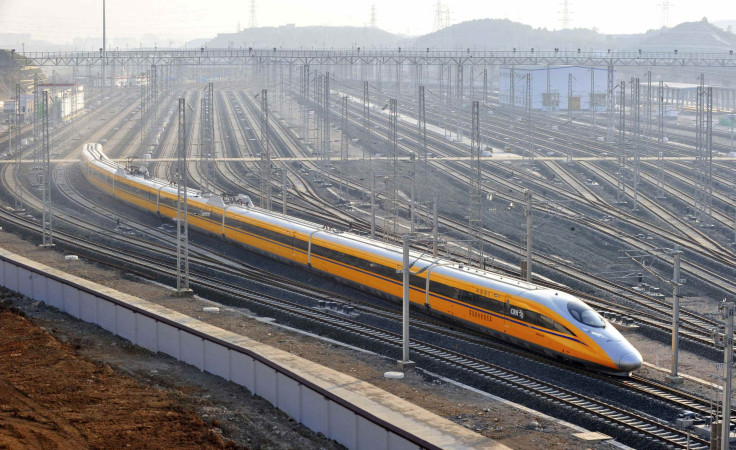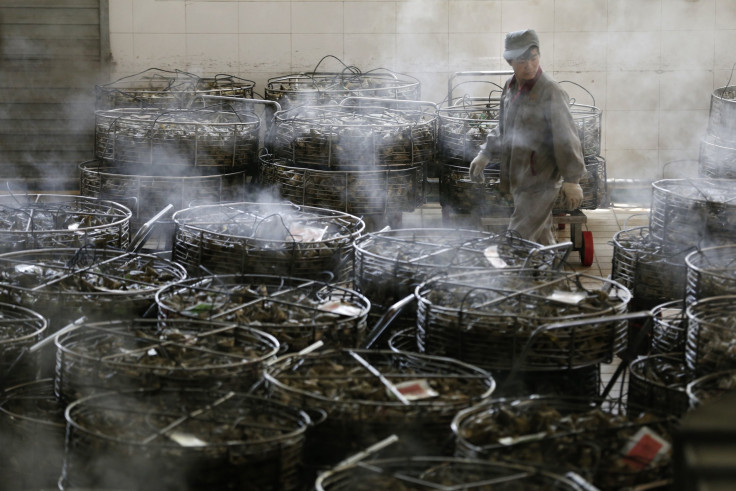China’s Growth Slows To 6.9% In 2015, Slowest In 25 Years, In Sign of Challenges For World's Second-Largest Economy

SHANGHAI — China’s economy grew by 6.9 percent last year, its slowest growth rate in a quarter of a century — a sign of the challenges facing the world’s second-largest economy as it grapples with slowing exports, signs that domestic demand may have peaked, and uncertainty over the government's policies for tackling a slump in its stock markets and a fall in its currency, the yuan.
State media said the GDP figure was within a "reasonable range," and more or less met the government’s growth target of “about 7 percent” for the year. However, it represented a sharp fall from 2014's growth rate of 7.3 percent — the fourth-quarter growth, 6.8 percent, was its slowest in six years and slightly below most economists’ predictions — a sign that “growth momentum slowed further” at the end of last year, Li-Gang Liu, chief economist for Greater China at ANZ Bank said in a note sent to International Business Times.
China's leaders have acknowledged the slowdown, setting a target of 6.5 percent for this year, and stressing that global economic factors are primarily to blame. The country's economy has been buffeted in particular by a sharp fall in demand for its exports — which fell for five straight months before a slight rebound in December in yuan terms, though they remained down 1.4 percent year-on-year in dollar terms.
But growth in domestic demand has also slowed. Data from China’s National Bureau of Statistics (NBS) showed that industrial output grew 6.1 percent last year, compared to 8.2 percent in 2014. And ANZ’s Liu noted that the rate slowed further in December, to 5.9 percent year-on-year, compared to a 6.2 percent rise in November.
China’s President Xi Jinping said Monday that the country was seeing “slower but more resilient growth.” And the figures suggest there are still some bright spots in the economy. High-tech sectors grew rapidly, with the value added of "new technology industry" up 10.2 percent, according to the NBS. Wages also continued to rise, with disposable income up 7.4 percent in real terms.
Retail sales also expanded rapidly, by 10.6 percent in 2015, with rural areas, seen as an area of untapped consumption potential, growing faster, by 11.8 percent. Auto sales — a booming sector which slowed sharply early last year — have also rebound in recent months following government incentives for buyers of smaller vehicles. Sales grew 16.9 percent year-on-year in December.

And growth in China’s service sector has speeded up. It expanded 8.3 percent in 2015, compared to 7.8 percent the previous year. Official statistics show that it contributed 50.5 percent of China's GDP in 2015, compared to 48.1% in 2014.
Matthew Crabbe, Director of Research, Asia Pacific at market research group Mintel, said these figures were a sign that government moves to end reliance on low-cost manufacturing were having some impact.
"This is a sign of growing maturity in the economy, and the impact of the restructuring which the government introduced after 2008,” he told IBT. “Growth may be slowing, but it’s better quality growth — the high proportion contributed by the service sector is a very good thing, and there’s much more potential there too. Consumers are upgrading to higher quality products, and using more services, especially online ones.”

Yet some economists say China should not become over reliant on services and consumption, with some arguing that the service sector is less productive. John Zhu, senior China economist at HSBC said in a recent report that “China needs industrial upgrading, and not a premature shift from industry to services.” He added: “Consumption is an effect — not a cause — of sustained long-run GDP growth, which depends instead on supply-side factors and labor productivity in particular.”
ANZ’s Liu, meanwhile, said that last year’s robust service growth was due, in part, to a rapid increase in financial services — some of them linked to the stock market, which grew rapidly in the first half of the year before slumping in June.
“A sustained growth in the financial sector at this pace is difficult, especially after the recent stock market routs,” he argued.
And Liu noted that, while retail sales grew 11.1 percent in December year-on-year, this was slightly down on the previous month. He also said that growth in fixed asset investment, mainly government spending on infrastructure, also fell in December, though such spending was still up 10 per cent year-on-year.
Some observers have predicted major government spending to boost the economy, and some sectors are still seeing significant investment — China spent some $125 billion on its rail network last year, and a similar sum is expected to be invested this year.

But the government has said it will be more cautious about infrastructure spending than it was after the global financial crisis seven years ago, and Finance Minister Lou Jiwei has said that the country cannot spend its way to recovery.
The government has used some policy tools: It cut interest rates six times last year, and ANZ predicted it could lower them further again this year, as well as cut the reserve requirement ratio for banks by a further 2 percentage points, making it easier for them to lend money for businesses to invest and citizens to spend.
Yet such “traditional fiscal and monetary policy will only have a secondary impact on the economy by mitigating the pace of the slowdown,” said ANZ's Liu, adding that it would be hard for such policies to “change the trend.”
He predicted growth could fall to 6.4 percent this year, and possibly as low as 6 percent next year, though he said there could be a “gradual rebound” from 2018, and China could still achieve the average of 6.5 percent growth, targeted by the authorities, over the period of the country’s next five-year plan, from 2015- 2020. But Liu said this would require the government to take “decisive measures to tackle the highly indebted corporate and local government sectors in the coming two years.”
Many analysts say the government faces significant challenges from bad debt as a result of loans extended by banks to state enterprises and local governments during the spending boom at the end of the last decade. This led to rapid expansion of the real estate sector, as well as infrastructure, which boosted commodities companies both in China and abroad. Yet the property sector has slowed sharply in recent years. While the NBS said that sales had rebounded last year, with sales of residential buildings growing by 16.6 %, home prices have continued to fall in many inland cities, according to the latest data. And investment in new real estate development — an important engine of growth in past years — was up just 2.8 percent in real (price adjusted) terms, and 1 percent in nominal terms, the NBS said. Land bought for real estate development, formerly an important source of local government income, fell significantly, meanwhile, by 31.7 percent on a year earlier.
Some analysts have said that slowdown in construction is healthy, given the vast stock of unsold housing in many Chinese towns and China’s cities. But it has posed challenges for real estate developers, many of which are struggling with dollar denominated loans. And the impact on China’s commodity sector was highlighted by reports Tuesday that Chinese steel firms, which grew rapidly during the construction boom, lost more than $8 billion in the first eleven months of last year.
The slowdown has left many Chinese heavy industries and raw materials producers struggling too, including major state-owned enterprises in sectors such as coal. The government has promised to tackle loss-making companies, dubbed “zombie enterprises,” in the coming years, as part of long-promised reforms of the state sector. However, it faces a huge challenge: One coal mining company in north-east China, Longmay, recently said it would have to lay off as many as 100,000 workers, while some analysts have said the need to find jobs for hundreds of thousands of soldiers due to be demobilized in a restructuring of China’s military may also discourage the government from closing large state enterprises.
Liu Yingqiu, dean of Center for Private Economic Studies at CASS, warned in the official Global Times Monday that dealing with zombie firms would be a “complicated process.” But he stressed that it was important to bite the bullet and embrace “the market’s deciding role in allocating resources.”
The Chinese government has pledged repeatedly to embrace “supply-side” policies in the coming year, which would allow markets to play a greater role. Yet concerns have been raised by what analysts say are unclear policies, both in the handling of the boom and bust on China’s stock market last year, and the depreciation of the yuan. After devaluing the yuan suddenly by some 3 percent last summer, the authorities said there was no need for it to fall further to boost exports, and intervened heavily on money markets to prop it up. Yet in early January, they first allowed it to fall further, before intervening again, leaving markets and investors confused, and contributing to burgeoning outflows of capital from China that, some economists say, could pose challenges for the authorities if they don’t get a grip on policy.

Joerg Wuttke, president of the European Chamber of Commerce in China, told IBT that foreign investors wanted to see faster policy moves towards “a more market-based economy” by the Chinese authorities. He said that while "the government talks about market opening … little substance follows." He said it was "telling that Chinese companies invested more than $20 billion in Europe last year, but European investment in China is a fraction of that," adding: "We could do more if markets are more open." He said there were also concerns about Chinese growth potential in the coming year, "in view of overcapacity and increasing debt burden in the economy."
Yet, while some analysts hope that slowing growth may push the Chinese government toward faster reforms, others worry that official anxiety about the social impacts of the slowdown could lead to a greater emphasis on stability, and therefore greater caution. As China embraces what the government calls "the new normal," the challenges are significant.
© Copyright IBTimes 2024. All rights reserved.






















